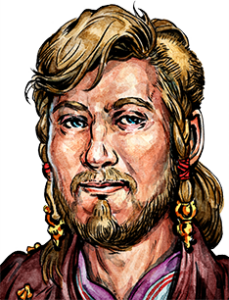Our series of interviews with team members continues with our lead artist, Jan Pospíšil.
What’s your background?
I have a master’s degree in computer graphics programming, but in art I’m self-taught.
How did you get into the industry?

I’ve been full-time freelancing for over 5 years now (I think). At first I posted my portfolio on a bunch of RPG forums and that got me a few hobbyist level jobs in pen and paper RPGs (which is where I would get the majority of work in the following years). Then in short succession Jeff Richard (then of Moon Design, now Chaosium) and Jon Hodgson (Cubicle 7) contacted me for work and I’ve been drawing for them ever since.
I was a big fan of Tolkien and also drew a lot of historical/ancient stuff and both those areas eventually became my “niche.”
When it comes to computer games, I started by modding during my uni studies. Curiously, neither my computer science degree, nor my modding efforts contributed to my first real videogame job – doing art for KoDP and Six Ages. (I have my continued work on pnp Glorantha to thank for that, I believe.)
What was the first gaming product you worked on, and in what capacity?
I have to admit I don’t remember. Unfortunately I lost a backup drive from that time, so there’s no way to check. Most likely it was a few pieces of black and white art for a supplement book by a small publisher.
The first product I consider a career changer was probably the Guide to Glorantha, for which I painted a series of colour plates.
How were you introduced to KoDP
Someone shared a few pictures from their game in a screenshot thread on the TaleWorlds forums. I was immediately interested, because I’ve never seen a game with art like that. Especially intriguing was a scene depicting Grazelanders, who I recognized as Scythian/Pazyryk inspired.
I had to know what this game was about! The concept sounded incredible and I immediately pirated it and spent a few weeks playing it to exhaustion. (Sorry about that! I’ve bought it on several platforms since then.)
How did your art style develop?
Chaotically and slowly. Before I started learning with some semblance of focus (in uni and on), I did everything by feeling and instinct. In a way that felt more free and I was far more daring in those days.
Now I’m mostly trying to get faster and away from aping my favourite artists too much. (Which I definitely did for some products I worked on, like Angus McBride in Glorantha, or Viktor Ambrus on “The One Ring.”)
I did a lot of ink drawing on Six Ages (as opposed to painting), which was very useful training in hindsight. I also practiced horses a lot, that’s always useful.
What was the most challenging part of the project?
The scope of it. Most projects in the past would take up to a few months to finish, followed by a period of crippling doubt (“Is any of this any good?!”), followed by the joy of seeing them in the hands of happy customers. Working on Six Ages meant four years of not being able to talk about anything I was doing, and there was so much of it to do! Definitely a different experience.
What was the best part of the project?
Seeing it all come together and working with the other members.
Reading Robin’s writing where he’d build on the concepts we came up with in preproduction, meeting the characters he created.
Seeing other artists do their thing and thinking: “Oh man, I wouldn’t have thought of that!”
Reading the testers’ experiences playing the game for the first time.
Other than Six Ages or King of Dragon Pass, what’s your favorite computer game?
Can’t easily reduce that to just one, so…
I’ve spent the most time with Mount&Blade:Warband (thousands of hours probably, since 2006).
The best recent game I played is The Witcher 3:Wild Hunt (I’ve been a fan of the Witcher books since childhood).
My “most interesting/innovative” recent game is Exanima – for its unusual physics-based combat system (having 238 hours played on Steam).
Amazing art work I’ve seen so far, Jan! I believe David mentioned once that Six Ages will contain more words than the first three Harry Potter novels combined, but how about illustrations? How many of those wonderful ink drawings did you and your fellow artists make? I love how they avoid the cliché Tolkien look.
Ah, several hundred, just for the scene art. Plus combat art, plus portraits, plus all special events and rituals…
Yeah, hundreds. 😉